|
|
|
Sort Order |
|
|
|
Items / Page
|
|
|
|
|
|
|
| Srl | Item |
| 1 |
ID:
135054
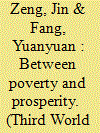

|
|
|
|
|
| Summary/Abstract |
Despite China’s rapid economic growth in the past three decades, Chinese officials and experts are increasingly worried that the country is slowly heading towards the ‘middle-income trap’. The fear is that China might suffer the same stagnation and turbulence as Latin American economies did in the 1980s and 1990s. Will China be able to avoid this trap? Building on the insights of world-systems theory, this paper argues that China’s dependent development, although enabling it to escape the ‘poverty trap’, is likely to bog it down in the ‘middle-income trap’. China’s heavy reliance upon foreign technologies and investment has harmful effects on its economy. Dependent development not only increases China’s economic vulnerability but also truncates domestic industries. To escape the trap, the Chinese state should play a more active role in shifting its growth model away from low-end commodity manufacturing to knowledge-based, high value-added activities.
|
|
|
|
|
|
|
|
|
|
|
|
|
|
|
|
| 2 |
ID:
143551
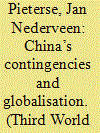

|
|
|
|
|
| Summary/Abstract |
Will China be able to rebalance its economy, heavily tilted towards investment? Will it be able to increase the share of household consumption in GDP? Will it turn steeply growing social inequality around? Will urbanisation contribute to China’s rebalancing or will it add to the imbalances? Will China manage to bring pollution under control? Such variables will determine whether China can move beyond the middle-income trap and also affect its external relations. In addition, China’s rebalancing is a variable in global rebalancing. This article provides an introduction to the special issue.
|
|
|
|
|
|
|
|
|
|
|
|
|
|
|
|
| 3 |
ID:
143530


|
|
|
|
|
| Summary/Abstract |
This study analyzes the household food demand followed by projecting the future level of demand of selected food commodity groups in Pakistan. It uses Pakistan Panel Household Survey (PPHS) for the year 2010, conducted by Pakistan Institute of Development Economics (PIDE). The linear approximation/almost ideal demand system (LA/AIDS) model is used to estimate the demand elasticities, while a simple growth model is used for food demand projections. The empirical results reveal that food grains, pulses, ghee, sugar and vegetables are necessities, while milk and meat are luxuries. Pulses and vegetables, ghee and meat, milk and sugar are identified as gross complements on the basis of uncompensated cross-price elasticities. The uncompensated cross-price elasticities of food grains indicate the substitutive relationship between different food items, such as pulses, meat and vegetables. An increase in the household income will induce a substantial expansion in household demand for milk and meat products, but the consumption of these foods will decline if household size grew, ceteris paribus.
|
|
|
|
|
|
|
|
|
|
|
|
|
|
|
|
| 4 |
ID:
129094
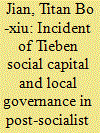

|
|
|
|
|
| Publication |
2014.
|
| Summary/Abstract |
This study makes use of the framework of social capital to explain the post-socialist governance model and characteristics of local governments in contemporary China. The incident of Tieben in April 2004 is selected as an example to explain how the local government developed social capital using informal mechanism and policy networks to facilitate economic development and to enhance government performance. thereby forming the so-called post-socialist local regime. During the incident of Tieben. the local movement collaborated with real estate developers and financial institutions. Farmers were excluded from this plan and their interests were sacri?ced. This study uses the concept of bonding social capital to explain this model. The model worked on the basis of the close relationship between specific groups rather than general trust and ptiblic participation. The majority of relevant sttitlies. on the other hated. show that instead of bonding social capital. bridging social capital is a better means to resolve the conflicts among nunicrous stib-grotips with vested interests. and to facilitate favorable economic and social performance. This paper hence contends that. although a local government may stimulate the development of social capital. the use of this governance model excites the participation and deprives cannot provide a useful guide for optimizing local government performance.
|
|
|
|
|
|
|
|
|
|
|
|
|
|
|
|
| 5 |
ID:
110286
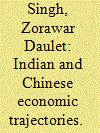

|
|
|
| 6 |
ID:
124885
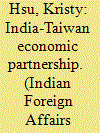

|
|
|
|
|
| Publication |
2013.
|
| Summary/Abstract |
Taiwan, a dynamic democracy and home to the world's leading ICT technology and manufacturing base, is now looking beyond its traditional trading partners and investment destinations, namely China and Southeast Asian countries, towards India as one of its most strategically important economic partner in its revised "Go South" policy for the next decades. As suggested by the new term of IT -- I stands for India and T stands for Taiwan, growing business interests in Taiwan, starting with ICT industry and expanding to other sectors, have driven considerable Taiwanese business delegations visiting India exploring emerging trade and investment opportunities
|
|
|
|
|
|
|
|
|
|
|
|
|
|
|
|
| 7 |
ID:
086592
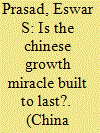

|
|
|
|
|
| Publication |
2009.
|
| Summary/Abstract |
Is the Chinese growth miracle - a remarkably high growth rate sustained for over two decades - likely to persist or are the seeds of its eventual demise contained in the policies that have boosted growth? For all its presumed flaws, the particular approach to macroeconomic and structural policies that has been adopted by the Chinese government has helped to deliver high productivity and output growth, along with a reasonable degree of macroeconomic stability. There comes a point, however, when the policy distortions needed to maintain this approach could generate imbalances, impose potentially large welfare costs, and themselves become a source of instability.
The traditional risks faced by emerging market economies, especially those related to having an open capital account, do not loom large in the case of China. In the process of securing protection against external risks, however, Chinese policymakers may have increased the risks of internal instability. There are a number of factors that could trigger unfavorable economic dynamics that, even if they don't rise to the level of a crisis, could have serious adverse repercussions on growth and welfare. The flexibility and potency of macroeconomic tools to deal with such negative shocks is constrained by the panoply of policies that has supported growth so far.
|
|
|
|
|
|
|
|
|
|
|
|
|
|
|
|
| 8 |
ID:
137517
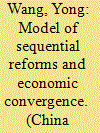

|
|
|
|
|
| Summary/Abstract |
Motivated by China's experience, a growth model is developed to explain the repeated interaction between economic reforms and growth in a developing country. Convergence occurs until the developing country reaches a bottleneck, then convergence stops unless the institution is improved. After the reform, convergence resumes until a new bottleneck is encountered, which triggers another reform, and so on. Using recursive methods, I show analytically that, in a perfect international credit market, each reform occurs when the new growth bottleneck just becomes binding; the reform size changes monotonically over time; there are finite reforms and convergence is unceasing until the last constraint binds, so a permanent GDP gap may exist. The model also implies that a politically more powerful government should adopt more gradual reforms. In an imperfect credit market, convergence can be delayed and an initially richer economy can be more likely to adopt insufficient reforms.
|
|
|
|
|
|
|
|
|
|
|
|
|
|
|
|
| 9 |
ID:
102684
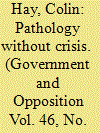

|
|
|
|
|
|
|
|